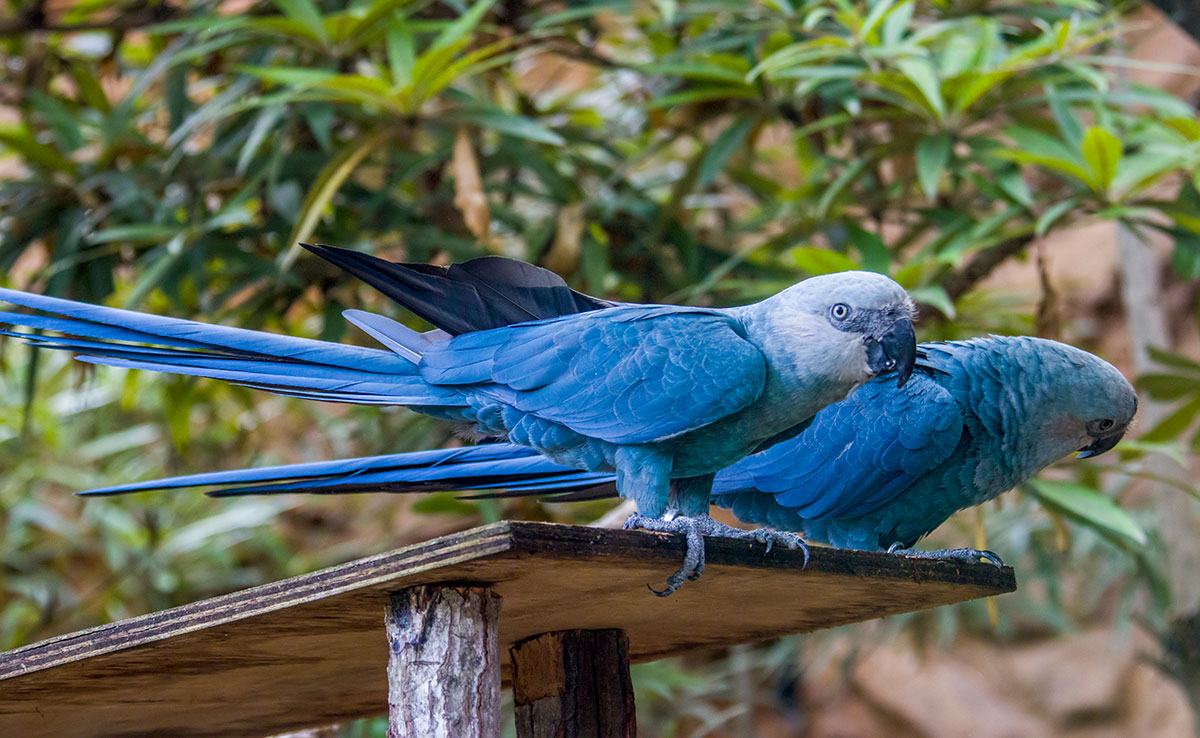
Ten of the Worlds Rarest Parrotlike Species
Parrots and their brethren are amongst the most easily recognised bird species on the planet. They belong to the Order – Psittaciformes, which contains in excess of 350 different species. Their range incorporates South America, Central America, Asia, Australia, and Africa. Many species are popular as pets given their generally bright colours, intelligence, and inquisitive natures. Sadly this combined with other man-made threats such as habitat destruction and the introduction of invasive species means many now face the fate which befell North America’s only ever endemic species the Carolina Parakeet – extinction.
Anyway here are ten that many will never have heard off and even fewer will have seen.
The Glaucous Macaw – Anodorhynchus glaucus
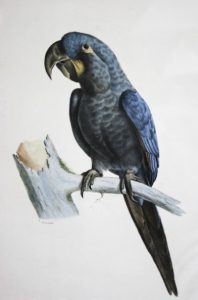
Bourjot Saint-Hilaire / Public domain
The Glaucous Macaw is (was?) native to South America in a fairly localised region covering Northern Argentina, South Paraguay, North-East Uruguay and bordering areas of Brazil. However, it has not been seen for many years and although it is possible some survive in the largely unexplored wilderness areas it is more likely that the species is now sadly extinct. None are known in captivity and according to the International Union for Conservation of Nature (IUCN) the last probable sightings were in Mbaracayu, Paraguay in the late 1990s and 2001.
New Caledonian Lorikeet – Charmosyna Diadema
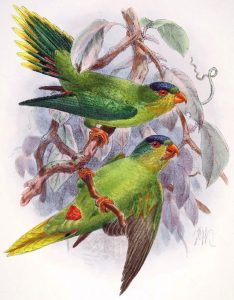
By John Gerard Keulemans – Public Domain, Link
Current Estimated Numbers: Possibly extinct in the wild; estimated to be fewer than 50
The New Caledonian Lorikeet is only known to exist on the Island of Malesia, New Caledonia and there have been no verified sightings since 1976. despite numerous efforts over the years to search for the parrot. Research teams were ent out in 2002 and 2011 to try and locate the New Caledonian Lorikeet and unfortunately, the elusive parrot still has not been found.
Researchers advise that the New Caledonian Lorikeet’s status be updated to Critically Endangered – Possibly Extinct because there are no signs of the bird in the wild. The New Caledonian Lorikeet has always been considered rare because the species is only known from a few specimens collected in 1859 and another from 1913. Due to this, the New Caledonian Lorikeet is tied with the Glaucous Macaw as the rarest parrot in the world.
Red-throated Lorikeet – Charmosyna Amabilis
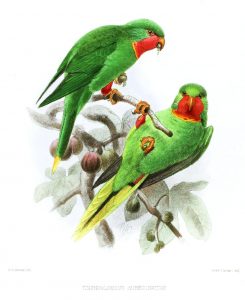
By :John Gerrard Keulemans, Public Domain, Link
The status of the Red-throated Lorikeet in the wild is unknown with the World Parrot Trust indicating that there have been no verified sightings since 1993 and that extensive searches of its last known habitat in 2002 & 03 failed to find any evidence of them still existing. For right now, the IUCN Red List considers the Red-throated Lorikeet to be critically endangered, but not yet extinct because there have been unverified sightings from time to time by locals however there is no known captive population and they estimate the number remaining as being between 1-49 which doesn’t sound too hopeful.
They were originally found in small numbers on the Fijian Islands of are found on Viti Levu, Ovalau, Vanua Levu and Taveuni, however, loss of habitat due to logging and road construction and introduced predators such as Black rats (Rattus rattus) & the Indian brown mongoose (Herpestes fuscus) has not helped their cause. A crumb of hope remains given that these were always elusive birds and their preferred habitat is upland rainforest there is a chance that a few small groups still survive. The IUCN has not given up hope yet because of this and the search is likely to continue. If any are discovered a program of captive breeding is envisaged.
New Caledonian Lorikeet – Charmosyna Diadema

By John Gerard Keulemans – Public Domain, Link
The New Caledonian Lorikeet as its name would suggest is only known to exist in New Caledonian island groups and sadly there have been no verified sightings since 1976. More recently research teams have tried to locate specimens but all including the last one in 2011 have been unsuccessful. The New Caledonian Lorikeet has always been rare and none are known in captivity. Even taxidermy specimens are rare with most of the ones in museums having been collected in the 1850s. Despite this, it is still possible that small pockets of population exist on the larger uninhabited islands (such as Pott & Tupeti Island)
Puerto Rican Amazon – Amazona Vittata
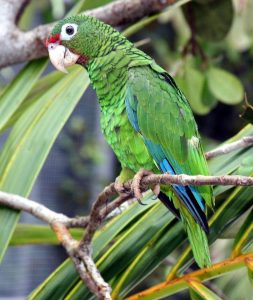
Image Credit: Tom MacKenzie / Public domain
This is the only remaining endemic parrot species to the Puerto Rican island group. Although once fairly common its numbers suffered a catastrophic decline in the early part of the 2oth and although efforts to halt the decline started as far back as 1968 the IUCN estimate that in the early 1970s as few as 13 were left in the wild. Fortunately, the United States Fish and Wildlife Service began a concerted effort to save the species and although it is still critically endangered there is now a sustainable captive population and up until Hurricanes Irma and Maria ravaged the area in 2017 the wild numbers were expanding. The latest numbers available in 2020 indicate that there are now around 500 in total, mostly in captivity.
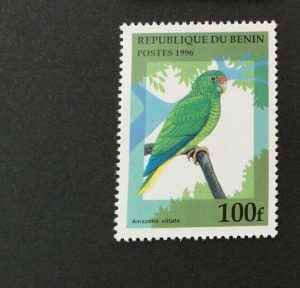
The Puerto Rican Amazon was the subject of this 1996 Benin stamp.
Orange-bellied Parrot – Neophema Chrysogaster
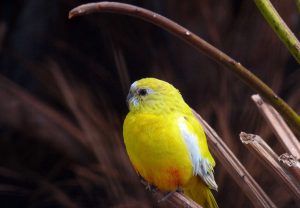
Image credit: Susan Flashman/Shutterstock.com
This attractive, somewhat diminutive bird, which is probably more akin to what most people would call a parakeet than a parrot once saw it numbers plunge to only 14 in the wild. However thanks to intense protection efforts and A successful captive breeding programme its numbers are climbing – although it remains critically endangered. Unlike other Parrot species, The Orange Bellied Parrot migrates from the Australian Mainland to its only remaining breeding ground at Melaleuca, Tasmania, which increases the pressure on them as many die on the trip. Further Feral cats are now a recognised problem in Tasmania and although they may only account for the odd loss when the numbers are this low it is an issue. There has been some good news numbers-wise in 2020 with around 118 expected to make the journey to their breeding grounds and it is hoped that more than the 23 who arrived in 2019 makes it this year.
Blue-throated Macaw – Ara Glaucogularis
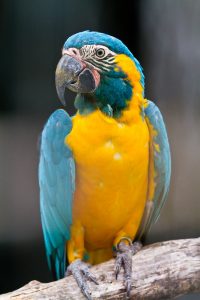
Image credit:Atthapol Saita/Shutterstock.com
At first glance it would be easy to mistake this species for its commoner brethren the Blue & Gold Macaw (Ara ararauna) which frequents the same area, however, the latter has a black throat area. Once thought to have been relatively widespread throughout Bolivia, their numbers have been devastated by a combination of scrubland clearance for cattle ranching, capture for the pet trade and hunting by the Moxeño people who used their feathers for traditional headdresses. They even face additional avian predation by Great Horned Owls who are amongst the most adaptable birds on the planet. L
Today they are only found in the Los Llanos de Moxos region of Bolivia and it is thought that between 300 & 400 remain in the wild, Still, things may be looking up thanks to legislation protecting them which was passed in 2014, and the decision by the Moxeño people to switch to using alternatives to Macaw feathers for their “machetero” ritual dances. With a captive breeding programme also contributing to their numbers the IUCN now list the species as Critically endangered but stable.
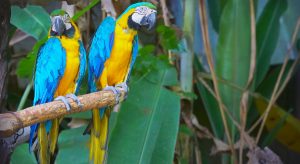
Image: thechatat/Shutterstock.com
Blue-Winged Racket-Tail – Prioniturus Verticalis
The Blue-Winged Racket-Tail or Sulu Racquet-tail which it is also known by was once found throughout the whole of the Sulu Archipelago in the Philippines, but now it is restricted to a single island province Tawi-Tawi. Although never common they were relatively abundant up until the 1970s when the wholesale deforestation of the peninsula began. It is thought as few as 250 individuals remain and the IUCN lists them as critically endangered and in decline. Sadly there does not seem to be any captive breeding programme or in-situ conservation efforts being made so unless this changes paintings such as the above may be the only way this species is remembered.
Kākāpō – Strigops habroptilus
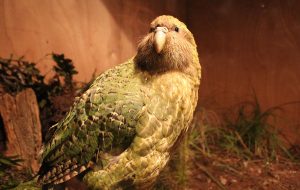
Image: Imogen-Warren/Shutterstock.com
The Kākāpō is native to New Zealand (which has the most flightless bird species in the world) and although once widespread have been threatened with extinction ever since the colonisation of the islands, which brought invasive species such as rats, cats and ferrets. In 2020 the New Zealand Department of Conservation, estimates there are 211 Kākāpō’s left and efforts to preserve them have been ongoing since 1894. The majority of those remaining in the wild are on isolated predator-free islands namely Codfish, Anchor, and Little Barrier.
They are very unusual parrots, to say the least, being both flightless and nocturnal! They are also the only parrot species to be lek breeders (the male taking no part in the raising of the offspring). These long-lived birds may not be the most colourful or graceful of the species, however, like their flightless compatriot the Kiwi they are a symbol of national pride for New Zealanders, and the most famous of them a male called Sirocco even has his own Facebook page and Twitter account! He was hatched in 1997 and all being well he will be acting as his species ambassador for a long time to come as they can live to be Ninety!
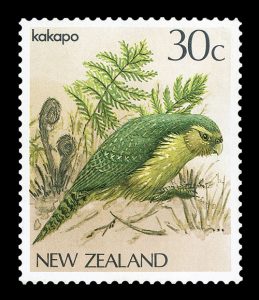
Kakapo’s have even featured on stamps
Spix’s Macaw – Cyanopsitta spixii
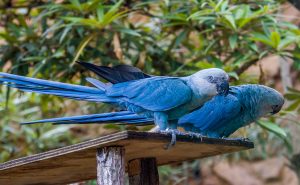
Image: Danny Ye/Shutterstock.com
Current Estimated Numbers: Extinct in the wild; 60 to 80 in captivity
Country of Origin: North, North Bahia, Brazil (near the São Francisco river)
The Spix Macaw, as can be seen from the pictures is a stunningly attractive species which is sadly now most likely extinct in the wild according to the IUCN. It is likely that the Spix Macaw which was never common in the first place and it was not formally named and identified until 1819 when German naturalist Johann Baptist von Spix acquired one. Habitat loss in its former range in the northeastern Brazilian state of Bahia, trapping for the pet trade and predation from introduced species has led to its now perilous decline, however, there is a breeding program and there has been a sighting in 2016 which gives some hope that there may be a few left in some of the more remote areas. The video below shows what might be the last ever wild sighting of the species which helped inspire local efforts to preserve the declining habitat.
Anyway, let’s finish on a slightly lighter note, which is the only film to date anyway inspired by a Spix Macaw – the animated movie Rio. Perhaps this will in some even small way heighten the plight of these beautiful birds and lead to further efforts to preserve them and all the other threatened species.
Before you go if you haven’t already don’t forget to join us here at Five Minutes Spare and then try one of our Parrot Quizzes.
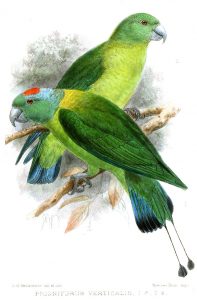
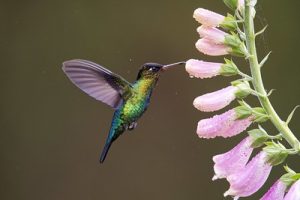
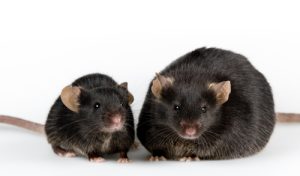
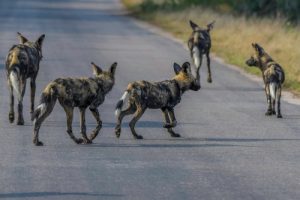
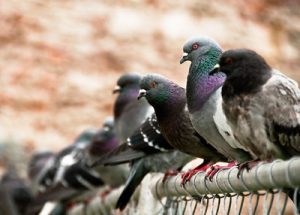
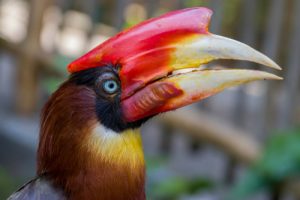
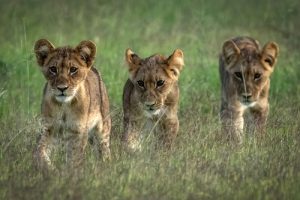
[…] You Have Tried The Quiz why not have a read about some of the worlds rarest parrots – surprisingly none are from […]